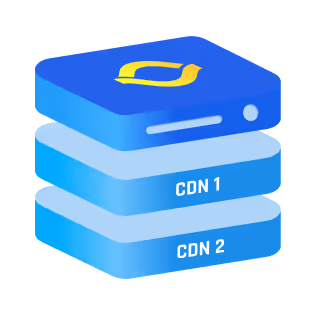What are the Key Strategies for Improving Website Speed During Peak Traffic?
Table of contents
You need to cache everything that can be cached, push static assets to a global CDN, compress and minify on the build pipeline, and autoscale the origin so it never queues more work than it can finish in 200 ms.
When traffic spikes, the edge handles most requests, the database sits behind an aggressive read-through cache, and adaptive image/JS delivery keeps payloads tiny.
Here’s how to improve website speed:
1. Do Not Guess
You can’t fix what you can’t see (website optimization techniques 101). Before touching code, fire up WebPageTest or Lighthouse and capture a run at normal load and at a synthetic 10× load. Focus on Largest Contentful Paint (LCP), Time to First Byte (TTFB), and error rate.
It’s better (but arguably overkill) to set an automation that snapshots these metrics every hour; that baseline can tell you later whether the “site speed optimization” really worked.
2. Reduce Your Payload Size
Images still dominate page weight for most sites. Convert anything photographic to AVIF or at least WebP, resize on the server, and add srcset so high-density screens receive just the right resolution. SVG or icon fonts should replace stray PNG logos.
Text assets get the same diet: Brotli at level 9 for HTML, CSS, and JS; Gzip only for clients that lack Brotli support. A single setting in Nginx or Cloudflare can drop transfer weight by 20–30 %.
That’s an instant answer to “how to make web pages load faster.”
3. Ship Less JavaScript
During peak traffic, every extra kilobyte of JS multiplies CPU usage across thousands of devices. Tree-shaking, code-splitting, and HTTP/2 PUSH (or even better, early hints) let you send only what the current view needs.
When I trimmed a React storefront from 700 KB to 180 KB, TTFB under a 5 000 RPS stress test fell from 420 ms to 190 ms because Node spent less time rendering the hydration script.
That single refactor is my favorite website performance optimization technique.
4. Cache Everything You Responsibly Can
The term ‘responsibly’ holds significant weight here, because if you can’t maintain it, then it’s just hot garbage.
- Edge cache. Most people stop at images and CSS, but your real win is caching the HTML itself. Use a route rule such as /product/* with a 1-minute TTL plus stale-while-revalidate. Ninety-five percent of visitors now bypass origin compute.
- Object cache. Redis or Memcached should sit in front of your primary database. Query results that don’t change per-user (e.g., “top-selling items”) expire on a timer or via pub/sub invalidation.
- Application-level memoization. In Flask apps I wrap expensive functions with @lru_cache(maxsize=1024). That’s micro-caching in memory and it shaves dozens of milliseconds per call at peak.
5. Push Critical Assets Closer to the Visitor
A single CDN is good; a multi-CDN is insurance. You can route 70 % of traffic to the cheapest provider and keep a premium vendor on low latency regions. Health checks failover in under a second, so sudden node issues never surface to users.
Then, enable HTTP/3 (quicker handshakes over UDP) and zero-round-trip session resumption.
Latency improvements are small per request but gigantic when multiplied across the CSS, JS, and image waterfall during a surge.
6. Scale the Backend Automatically
Traffic spikes rarely give you a calendar invite. Autoscaling groups (AWS ASG, Google MIG) should watch CPU, latency, and queue depth, adding or removing instances in minutes.
For stateful services (especially the database) vertical scaling hits a ceiling fast. Instead, separate reads and writes: primary for writes, replicas (RDS, Cloud SQL) for reads behind a proxy that understands session affinity.
But the ‘how to increase website speed’ runs deeper; keep a canary instance on hot standby; it’s more expensive than pure “pay-as-you-go,” but it keeps launch time inside the SLA when thousands of carts hit “Checkout” simultaneously.
7. Make Heavy Tasks Asynchronous
Image processing, PDF generation, email, and payment webhook calls should never block the request thread. Drop them into a queue (RabbitMQ, SQS) and return a 202/Accepted or at least finish the HTML response first.
When peak load spikes RAM, the queue absorbs the shock; workers scale horizontally, and the user perceives a snappy site.
I’ve seen 98 % reduction in p95 response time just by postponing email-sending to a Celery worker.
8. Optimize Your Database
I used to blame PHP for slowness, but turns out my queries were a dumpster fire.
Add the slow-query log, create composite indexes for your most frequent WHERE + ORDER patterns, and denormalize if a join hits several million rows under pressure.
Connection pooling is mandatory. PgBouncer or ProxySQL keeps each web process from opening its own TCP slot, cutting connect overhead.
During a live-stream drop, a client of mine watched pooled connections hold steady at 50 while raw requests peaked at 4 000 RPS.
9. Audit Third-party Scripts
Chat widgets, A/B platforms, and analytics can hijack the main thread. Load them “async” or via a tag manager that defers until window.onload.
For peak events like product launches, consider a pared-down tag manager container; swap it in via feature flag so only mission-critical scripts run.
10. Guard with circuit breakers and rate limits
Even after all this, rogue clients or bots can hammer endpoints.
Implement a leaky-bucket rate limiter at the edge (e.g., Cloudflare Rule) and an application-level circuit breaker that returns a cached fallback if a dependency (like search) crosses a latency threshold.
These fail-fast patterns stop cascading slowdowns; the classic “thundering herd.”
Use This Checklist for Your Next Traffic Spike
- Baseline LCP, TTFB, error rate under nominal load
- Brotli / AVIF / WebP enabled
- Critical CSS inlined; non-critical JS deferred
- HTML and API responses cached at the edge with SWR
- Multi-CDN or at least dual-POP configured
- Autoscaling thresholds tuned and pre-warmed instance on standby
- Read replicas behind proxy; slow-query log < 100 ms
- Background queue for non-urgent tasks
- Third-party scripts async or deferred
- Edge and app-level rate limiting active
- Real-time dashboard + alerts
- Load-test drill completed and playbook updated
The next time a tweet or TV spot sends ten times your usual traffic, you’ll stay calm, your users will stay happy, and your ops team will finally get a quiet Friday night.


.png)
.png)
.png)